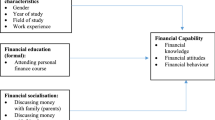Abstract
Very little prior research has examined public perceptions of research funding and the life chances associated with various fields of study. In the present task, 315 members of the Austrian general public rated 34 higher-education courses in terms of funding cuts or increases, and the perceived life chances of graduates, respectively. The results showed a high degree of correspondence in the ratings of both questionnaires. Overall, professional and biological stream courses were rated the most favourably, whereas arts and humanities courses were rated the least favourably. Participants’ demographic variables had little influence on their decisions. The implications of these findings for the way higher education is managed and organised are discussed.
Similar content being viewed by others
References
Ascher, K. (1984). Masters of business? London: Harbridge House Europe.
Baruch, Y., & Peiperl, M. (2000). The impact of an MBA on graduate careers. Human Resource Management Journal, 10, 69–90. doi:10.1111/j.1748-8583.2000.tb00021.x.
Behling, O., & Law, K. S. (2000). Translating questionnaires and other research instruments: Problems and solutions. Thousand Oaks, CA: Sage.
Berger, M. C. (1988). Predicted future earning and choice of college major. Industrial and Labor Relations Review, 41, 418–429. doi:10.2307/2523907.
Carnall, C. A. (1992). MBA futures. Basingstoke: Macmillan.
Cattell, R. B. (1966). The screen test for the number of factors. Multivariate Behavioral Research, 1, 140–161.
Cebula, R. J., & Lopes, J. (1982). Determinants of student choice of undergraduate major field. American Educational Research Journal, 19, 303–312.
Davies, S., & Guppy, N. (1997). Fields of study, college selectivity, and student inequalities in higher education. Social Forces, 75, 1417–1438. doi:10.2307/2580677.
Furnham, A. (1988). Lay theories: Everyday understanding of problems in the social sciences. Oxford: Pergamon Press.
Furnham, A. (2002). Losing your faculties: Tax payers’ perceptions of the value of university faculties. Higher Education Review, 34, 43–50.
Furnham, S., & Sisterson, G. (2000). Closing university departments: The perception of tax payers. Higher Education Review, 32, 45–52.
Halsey, A. (1982). The decline of the donnish dominion. Oxford Review of Education, 8, 215–229. doi:10.1080/0305498820080301.
Heckathorn, D. D. (1997). Respondent-driven sampling: A new approach to the study of hidden populations. Social Problems, 44, 174–199. doi:10.1525/sp.1997.44.2.03x0221m.
Kline, P. (1986). Handbook of test construction. London: Routledge and Kegan Paul.
MacErlean, N. (1993). Master classes. Accountancy, 111, 29–34.
Rumberger, R. W., & Thomas, S. L. (1993). The economic returns to college major, quality and performance: A multilevel analysis of recent graduates. Economics of Education Review, 12, 1–19. doi:10.1016/0272-7757(93)90040-N.
Schofield, P. (1996). The MBA: Managers only, please. Accountancy, 117, 40–42.
Schomburg, H. (2007). The professional success of higher education graduates. European Journal of Education, 42, 35–57. doi:10.1111/j.1465-3435.2007.00286.x.
Soares, V., & Amaral, A. (1999). The entrepreneurial university: A fine answer to a different problem? Higher Education in Europe, 24, 11–21. doi:10.1080/0379772990240102.
Tabachnick, B. G., & Fidell, L. S. (2001). Using multivariate statistics (4th ed.). New York, NY: HarperCollins.
Tang, T., & Chamberlain, M. (1997). Attitudes towards research and teaching: Differences between administrators and faculty members. The Journal of Higher Education, 68, 212–237. doi:10.2307/2959957.
Universities UK. (2002). Patterns of higher education institutions in the UK: Second report. London: Universities UK.
Wagner, A. (1996). Financing higher education: New approaches, new issues. Higher Education Management, 8, 7–21.
Watson, D. (2003). Universities and civic engagement: A critique and a prospectus. Paper presented at the Second Biennial Inside-Out Conference on the Civic Role of Universities, Brisbane, July 23.
West, P. (1996). Funding universities: The management challenge. Higher Education Management, 8, 125–131.
Wolf, A. (2002). Does education matter? Myths about education and economic growth. London: Penguin.
Author information
Authors and Affiliations
Corresponding author
Rights and permissions
About this article
Cite this article
Swami, V., Furnham, A., Haubner, T. et al. The correspondence of public perceptions of graduates’ life chances and university departmental funding. High Educ 59, 105–113 (2010). https://doi.org/10.1007/s10734-009-9237-6
Received:
Accepted:
Published:
Issue Date:
DOI: https://doi.org/10.1007/s10734-009-9237-6




